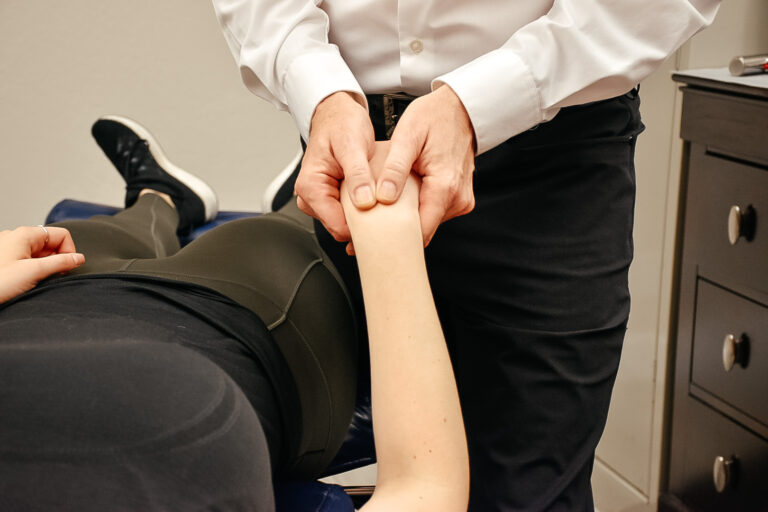Carpal Tunnel Syndrome
Care through chiropractic - Carpal Tunnel Syndrome
Carpal Tunnel Syndrome and Chiropractic
Carpal Tunnel Syndrome is a problem of the median nerve. Subsequently the nerve gets entrapped in a small tunnel at the wrist. As a result, this causes pain, weakness and possibly numbness of the hand, wrist and forearm. The result is tingling, burning, itching, numbness and pain. Carpal Tunnel Syndrome causes a major impact on the workforce with disability resulting during episodes due to the severity of symptoms. Therefore, a comprehensive approach to treatment is needed.
Treatment may include chiropractic joint manipulation of the wrist and hand. Stretches, strengthening exercises, and soft tissue mobilization are important, but similarly physical therapy modalities can help to stabilize your symptoms. Moreover, even though the wrist is a small part of the body, it takes a varied approach to treat it successfully.
Most importantly, regular breaks will be needed. Similarly, ice can be used at the end of the day to decrease swelling. In addition sleeping with wrist braces can help reduce the stress on the wrists. Having a workspace ergonomic evaluation can help to improve your workstation. In short, this approach can lead to a dramatic reduction in symptoms.
Dr. Cady has been successfully treating Carpal Tunnel and wrist symptoms for over 30 years. He has helped to keep many many computer professionals working despite the heavy stress on their wrists and arms. Come in for an evaluation today.
Anatomy
The Carpal Tunnel is located in the underside of the wrist. It is a passageway through which the Median nerve travels. It leads to the hand and fingers. Along with the Median nerve, the carpal tunnel contains the nine tendons. These tendons are for the forearm muscles. They are responsible for bending and flexing the fingers and thumb.
It’s important to note that carpal tunnel syndrome can be caused by a variety of factors, including repetitive hand and wrist movements, pregnancy, arthritis, diabetes, and obesity. Diagnosis of carpal tunnel syndrome involves a physical exam, medical history, and possibly nerve conduction tests.

In addition to the treatment options mentioned earlier, other conservative treatments for carpal tunnel syndrome include wearing wrist splints, modifying daily activities to reduce stress on the wrist, and taking anti-inflammatory medication. In more severe cases, surgery may be necessary to relieve pressure on the median nerve.
If you are experiencing symptoms of carpal tunnel syndrome, it’s important to seek medical attention early on to prevent long-term damage to the nerve and hand. Dr. Cady and his staff can provide a comprehensive approach to treatment that is tailored to your individual needs.
Common Causes
Some common causes and associated conditions are:
- Repetitive grasping
- Forceful grasping
- Prolonged computer usage
- Repetitive bending of the wrist
- Broken or dislocated bones in the wrist
- Arthritis
- Thyroid gland imbalance
- Diabetes
- Hormonal changes associated with menopause or pregnancy
The extensive use of computers and other electronic devices that require repetitive hand movements, such as typing and using a mouse, can lead to carpal tunnel syndrome. This is especially true for those who maintain poor posture or work in awkward positions, which can increase pressure on the median nerve. It’s important to take regular breaks and practice proper ergonomics to reduce the risk of developing carpal tunnel syndrome.
Case studies show that chiropractic made a demonstrable difference through objective and subjective outcomes. (read more)
Treatment of Carpal Tunnel Syndrome
Proper diagnosis and management of this condition is essential. Early intervention is essential to curtail the disabling symptoms of CTS. Dr. Cady is qualified to deal with this problem. He can help many sufferers achieve relief.
Treatment can include:
- Adjustments of the dysfunctional joints of the wrist improve motion
- Ultrasound to help reduce inflammation
- Ice similarly reduces inflammation
- Electrical therapy to strengthen weak muscles of the forearm
- In addition specific exercises to stretch and/or strengthen muscles of the forearm and hand
- Soft tissue massage stretches contracted tissues
- You might be advised to wear a splint or support. This is especially beneficial during sleep, to help hold the wrist in a neutral position to relieve pressure at the carpal tunnel.
- To sum up, treatment requires a broad approach
